Rear-facing child restraint installation using LATCH
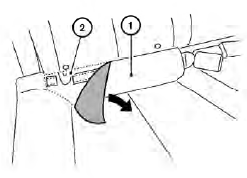
Refer to all Warnings and Cautions in the “Child Safety” and “Child Restraint” sections before installing a child restraint.
Follow these steps to install a rear-facing child restraint using the LATCH system:
1. If the rear seat cushion has a flap 1 , pull the flap down to allow access to the anchors 2 .
2. Position the child restraint on the seat. Always follow the child restraint manufacturer’s instructions.
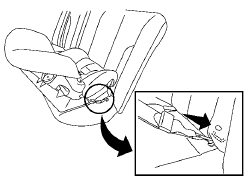
Rear-facing web-mounted – step 3
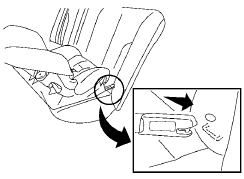
Rear-facing rigid-mounted – step 3
3. Secure the child restraint anchor attachments to the LATCH lower anchors. Check to make sure the LATCH attachment is properly attached to the lower anchors.
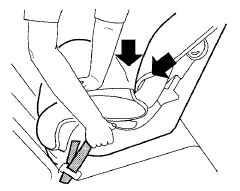
Rear-facing – step 4
4. For child restraints that are equipped with webbing-mounted attachments, remove any additional slack from the anchor attachments. Press downward and rearward firmly in the center of the child restraint with your hand to compress the vehicle seat cushion and seatback while tightening the webbing of the anchor attachments.
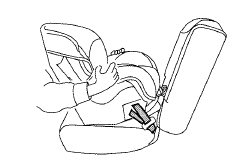
Rear-facing – step 5
5. After attaching the child restraint, test it before you place the child in it. Push it from side to side while holding the child restraint near the LATCH attachment path. The child restraint should not move more than 1 inch (25 mm), from side to side. Try to tug it forward and check to see if the LATCH attachment holds the restraint in place. If the restraint is not secure, tighten the LATCH attachment as necessary, or put the restraint in another seat and test it again. You may need to try a different child restraint or try installing by using the vehicle seat belt (if applicable). Not all child restraints fit in all types of vehicles.
6. Check to make sure the child restraint is properly secured prior to each use. If the child restraint is loose, repeat steps 2 through 5.
See also:
Fuses
Two types of fuses are used. Type A is used in
the fuse boxes in the engine compartment. Type
B is used in the passenger compartment fuse
box.
Type A fuses are provided as spare fuses. They
are ...
Reporting safety defects
For USA
If you believe that your vehicle has a defect
which could cause a crash or could
cause injury or death, you should immediately
inform the National Highway Traffic
Safety Administratio ...
Capacities and recommended fuel/lubricants
1: For additional information, see “Engine oil” in the “8. Maintenance and
do-it-yourself” section for changing engine oil.
2: For additional information, see “Engine oil and oil filter ...
